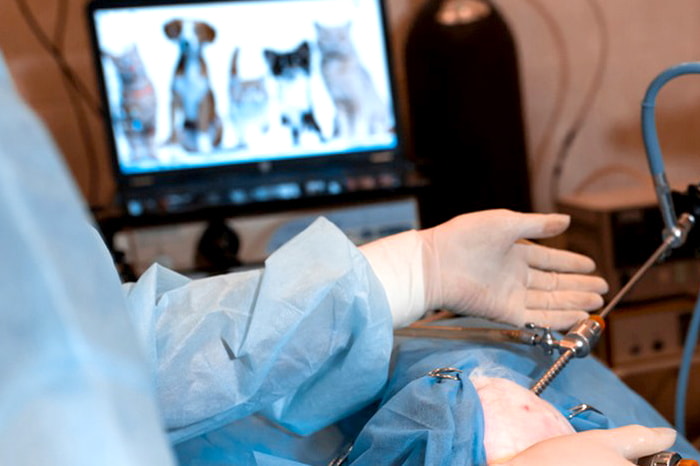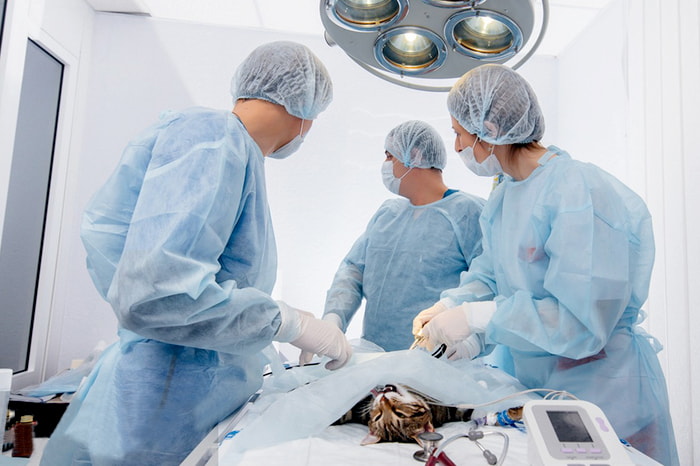Performing minimally invasive laparoscopic surgeries benefits our pet patients in many ways, including:

·Smaller incisions: Unlike traditional surgery, which often requires larger incisions, minimally invasive surgery relies on tiny incisions just large enough to insert a thin tube, small camera, fiber-optic light, and other small surgical tools.
·Less pain: These procedures cause less pain and discomfort for our patients. Studies have shown that patients recovering from minimally invasive surgery experience less pain and do not need the larger doses of pain relievers that are required by pets who have undergone conventional surgery.
·Increased accuracy: Minimally invasive surgery also offers a higher level of accuracy and precision compared to traditional open surgery. Accuracy is improved thanks to the use of a camera and fiber-optic light, which provides our surgeons with a better visualization of the internal organs.
·Shorter hospital stays: In most cases, patients undergoing minimally invasive surgery can return home the same day or sooner and return to normal activities sooner.
·Faster recovery: With a smaller incision, fewer stitches are required, and your pet can heal faster and return to their normal life much more quickly.
·Less scarring: Another benefit of having a smaller incision is having less noticeable scarring after the incision has healed.
·Less chances for infection:

Procedures We Perform with Minimally Invasive Surgery
Avian and Exotics Commonly performed Endoscopic Procedures.
Avian Endoscopic procedures:
·Oculoscopy (Eye evaluation)
·Tracheoscopy (Examination of trachea and Syrinx, Foreign body removal, granuloma removal, Sample collections, etc.)
·Upper Gastrointestinal endoscopy (Esophagus/Proventriculus/Ventriculus)
·Cloacoscopy (Evaluation of the cloaca, Urodeum, Coprodeum)
·Celioscopy Uni lateral and or Bilateral (Diagnostic Procedures, Sample collection, Cultures, debridement, Sexing (Gender identification))
·Avian Multiple entry minimal access endo-surgery (Orchidectomy, Salpingectomy, Biopsies, Granuloma/Mass removal)
Small Mammals Endoscopic Procedures:
·Otoscopy
·Oculoscopy
·Stomatoscopy
·Rhinoscopy
·Tracheoscopy
·Colonoscopy
·Vaginoscopy
·Colposcopy
·Cystoscopy
·Laparoscopy/Multiple entry Minimal access endo surgeries (Liver Biopsies, Kidney biopsies, Minimal Access ovariectomies, ovariohysterectomies, Retained testicle orchidectomy, laparoscopically assisted bladder stone removal
Reptile Endoscopic Procedures:
·Tracheoscopy
·Esophagoscopy/Gastroscopy
·Pulmonoscopy (Transcutaneous lung examination)
·Celioscopy (Biopsy collections, Culture, Gender identification, Gonadectomy)
·Cloacoscopy
Canine and Felines Commonly performed endoscopies:
Respiratory system Endoscopy
·Rhinoscopy
·Tracheoscopy
·Bronchoscopy
Intracavitary Laparoscopic procedures
·Laparoscopic ovariectomy
·Laparoscopic ovariohysterectomy
·Laparoscopically assisted gastropexy
·Liver biopsies
·Pancreatic biopsy
·Renal (Kidney) biopsies
·Lymph node biopsies
·Castration of cryptorchid animals
·Endoscopic abdominal exploratory
·Gallbladder bile collection to relief and culture purposes
·Splenectomies
Otoscopic exam,
·Otoscopy deep cleaning,
·Myringotomy
Gastrointestinal Endoscopy
·Lower (Colonoscopy)
·Upper (Esophagoscopy/Gastroduodenoscopy)
·Gastrointestinal foreign body removals
Endourology Exams and interventions
·Cystoscopy in females,
·Endoscopically assisted cystoscopy in males
·Laparoscopically assisted cystotomies for biopsy, cultures and stone removal
·Vaginoscopy